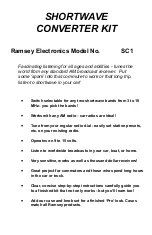
It is important that you determine both the “peak power” and “continuous
power” demands of any device you plan to operate using your power
inverter. The power demands of any particular device are usually stamped or
printed on the device and are usually expressed in either Wattage (Watts) or
Amperes (Amps). If this information is not indicated or the device, reference
that device’s owner’s manual or contact the manufacturer to ensure that it is
compatible with a modified sine wave power source.
To determine the power needs of a particular device, use the following
formulas:
Amps Indicated x 110 (AC Voltage) = Watts
(This Wattage amount is roughly equivalent to the “continuous power”
demand.)
Watts x 2 = “Peak Power”
(This is roughly equivalent to the initial “peak power” demand of the device at
start-up.)
In most cases, the “peak power” demand of the device is the determining
factor in whether your power inverter has the capacity to power that device.
To determine whether your inverter has the capacity to power a specific
device, test that device using your power inverter.
Your SOLAR power inverter is designed to automatically shut down in the
event of a power overload. This feature protects the inverter in the event that
you attempt to power a device with a power demand exceeding the inverter’s
capacity.
If a specific device that is close to the maximum operating range of your
power inverter will not power properly using the power inverter, turn the
inverter power switch
ON
(I),
OFF
(O) and
ON
(I) again in quick succession. If
this procedure is not successful, it is likely that your power inverter does not
have the capacity to operate that particular device.
In the event the automatic shut down protection occurs or the inverter
sounds a continuous audible alarm, turn
OFF
the power inverter immediately.
Do not re-start the SOLAR power inverter until the source of the problem has
been identified and corrected.






























